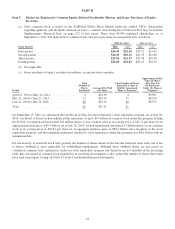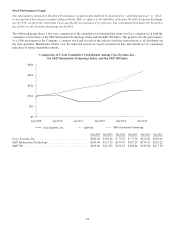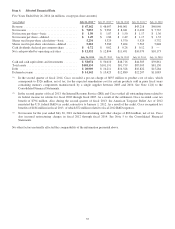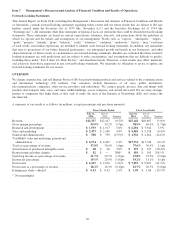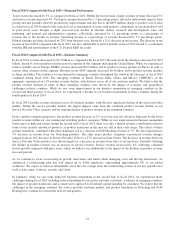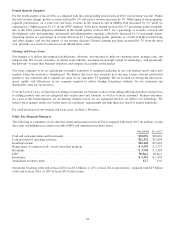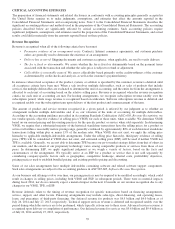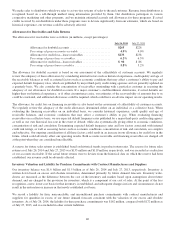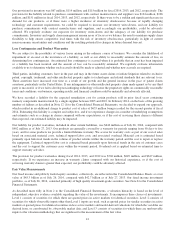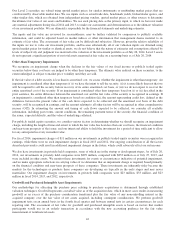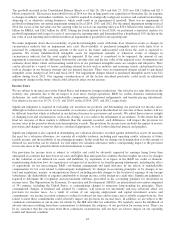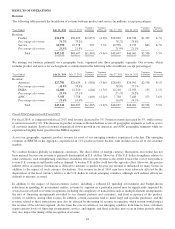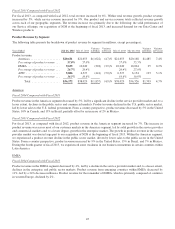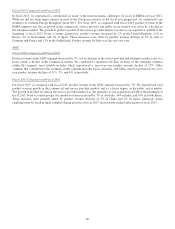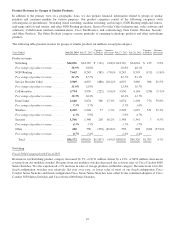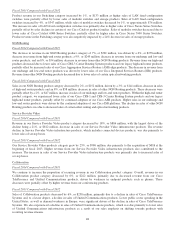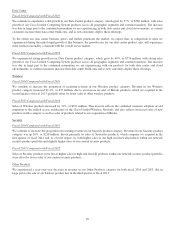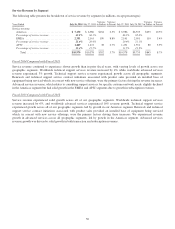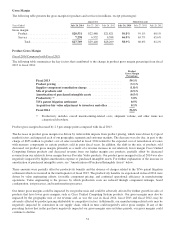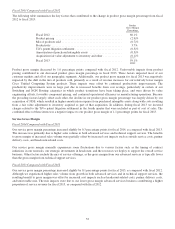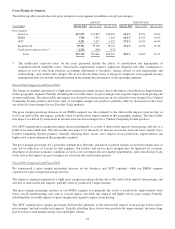Cisco 2014 Annual Report Download - page 51
Download and view the complete annual report
Please find page 51 of the 2014 Cisco annual report below. You can navigate through the pages in the report by either clicking on the pages listed below, or by using the keyword search tool below to find specific information within the annual report.The goodwill recorded in the Consolidated Balance Sheets as of July 26, 2014 and July 27, 2013 was $24.2 billion and $21.9
billion, respectively. The increase in goodwill for fiscal 2014 was due in large part to our acquisition of Sourcefire, Inc. In response
to changes in industry and market conditions, we could be required to strategically realign our resources and consider restructuring,
disposing of, or otherwise exiting businesses, which could result in an impairment of goodwill. There was no impairment of
goodwill resulting from our annual impairment testing in fiscal 2014, 2013, and 2012. For the annual impairment testing in fiscal
2014, the excess of the fair value over the carrying value for each of our reporting units was $32.0 billion for the Americas, $22.0
billion for EMEA, and $16.2 billion for APJC. During the fourth quarter of fiscal 2014, we performed a sensitivity analysis for
goodwill impairment with respect to each of our respective reporting units and determined that a hypothetical 10% decline in the
fair value of each reporting unit would not result in an impairment of goodwill for any reporting unit.
We make judgments about the recoverability of purchased intangible assets with finite lives whenever events or changes in
circumstances indicate that an impairment may exist. Recoverability of purchased intangible assets with finite lives is
measured by comparing the carrying amount of the asset to the future undiscounted cash flows the asset is expected to
generate. We review indefinite-lived intangible assets for impairment annually or whenever events or changes in
circumstances indicate that the asset might be impaired. If the asset is considered to be impaired, the amount of any
impairment is measured as the difference between the carrying value and the fair value of the impaired asset. Assumptions and
estimates about future values and remaining useful lives of our purchased intangible assets are complex and subjective. They
can be affected by a variety of factors, including external factors such as industry and economic trends, and internal factors
such as changes in our business strategy and our internal forecasts. There were no impairment charges related to purchased
intangible assets during fiscal 2014 and fiscal 2013. Our impairment charges related to purchased intangible assets were $12
million during fiscal 2012. Our ongoing consideration of all the factors described previously could result in additional
impairment charges in the future, which could adversely affect our net income.
Income Taxes
We are subject to income taxes in the United States and numerous foreign jurisdictions. Our effective tax rates differ from the
statutory rate, primarily due to the tax impact of state taxes, foreign operations, R&D tax credits, domestic manufacturing
deductions, tax audit settlements, nondeductible compensation, international realignments, and transfer pricing adjustments.
Our effective tax rate was 19.2%, 11.1%, and 20.8% in fiscal 2014, 2013, and 2012, respectively.
Significant judgment is required in evaluating our uncertain tax positions and determining our provision for income taxes.
Although we believe our reserves are reasonable, no assurance can be given that the final tax outcome of these matters will not
be different from that which is reflected in our historical income tax provisions and accruals. We adjust these reserves in light
of changing facts and circumstances, such as the closing of a tax audit or the refinement of an estimate. To the extent that the
final tax outcome of these matters is different than the amounts recorded, such differences will impact the provision for
income taxes in the period in which such determination is made. The provision for income taxes includes the impact of reserve
provisions and changes to reserves that are considered appropriate, as well as the related net interest and penalties.
Significant judgment is also required in determining any valuation allowance recorded against deferred tax assets. In assessing
the need for a valuation allowance, we consider all available evidence, including past operating results, estimates of future
taxable income, and the feasibility of tax planning strategies. In the event that we change our determination as to the amount of
deferred tax assets that can be realized, we will adjust our valuation allowance with a corresponding impact to the provision
for income taxes in the period in which such determination is made.
Our provision for income taxes is subject to volatility and could be adversely impacted by earnings being lower than
anticipated in countries that have lower tax rates and higher than anticipated in countries that have higher tax rates; by changes
in the valuation of our deferred tax assets and liabilities; by expiration of or lapses in the R&D tax credit or domestic
manufacturing deduction laws; by expiration of or lapses in tax incentives; by transfer pricing adjustments, including the effect
of acquisitions on our intercompany R&D cost-sharing arrangement and legal structure; by tax effects of nondeductible
compensation; by tax costs related to intercompany realignments; by changes in accounting principles; or by changes in tax
laws and regulations, treaties, or interpretations thereof, including possible changes to the taxation of earnings of our foreign
subsidiaries, the deductibility of expenses attributable to foreign income, or the foreign tax credit rules. Significant judgment is
required to determine the recognition and measurement attributes prescribed in the accounting guidance for uncertainty in
income taxes. The Organisation for Economic Co-operation and Development (OECD), an international association comprised
of 34 countries, including the United States, is contemplating changes to numerous long-standing tax principles. These
contemplated changes, if finalized and adopted by countries, will increase tax uncertainty and may adversely affect our
provision for income taxes. As a result of certain of our ongoing employment and capital investment actions and
commitments, our income in certain countries is subject to reduced tax rates and in some cases is wholly exempt from tax. Our
failure to meet these commitments could adversely impact our provision for income taxes. In addition, we are subject to the
continuous examination of our income tax returns by the IRS and other tax authorities. We regularly assess the likelihood of
adverse outcomes resulting from these examinations to determine the adequacy of our provision for income taxes. There can
be no assurance that the outcomes from these continuous examinations will not have an adverse impact on our operating
results and financial condition.
43


